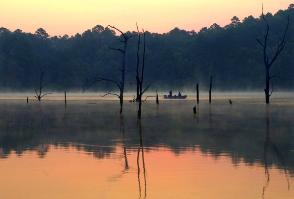OKLAHOMA CITY — Catch a large striped bass in the Broken Bow Reservoir and you might as well throw it back. The bass isn’t safe to eat, according to a Mercury in Fish study released Wednesday.
Sixteen state lakes have some species of fish with mercury levels above what is considered safe for unlimited consumption, according to the report released by the Oklahoma Department of Environmental Quality.
Two of the 16 lakes had “do not eat” advisories for certain species.
The advisory on striped — or hybrid — bass at Broken Bow includes consumption by both sensitive and general populations.
Sensitive populations include women of child-bearing age and children 15 and younger.
The study also advises sensitive populations not to eat walleye or white bass caught at Broken Bow.
Sensitive populations also should not eat white bass caught from McGee Creek Reservoir in Atoka County.
Jay Wright, manager of DEQ customer services, said the mercury concentrations in fish were consistently higher in Southeastern Oklahoma lakes, but officials are not entirely sure why.
Specific advisories on how much of which species of fish is safe to eat may be viewed at tulsaworld.com/deqfish for the following lakes: Atoka Lake, Boomer Lake, Broken Bow Reservoir, Coalgate City Lake, Draper Lake, Elmer Thomas Lake, Hugo Lake, Kaw Reservoir, Lake Heyburn, McAlester City Lake, McGee Creek Reservoir, Pine Creek Reservoir, Quanah Parker Lake, Rush Lake, Sardis Lake and Wister Lake.
Whitefish is an excellent source of protein, Wright said, but people should know how much fish is safe to eat from particular lakes.
“The advice we give to people needs to balance the risks versus the benefits,” he said. “We want people to continue to fish. We want them to eat the fish they catch.”
Mercury is a neurotoxin and is especially dangerous to developing fetuses and children. It can interfere with thinking, memory, attention span, fine motor and visual spatial skills.
Ninety-nine percent of human exposure to mercury comes from eating fish.
Predator fish species have the highest levels of mercury because they are the biggest, officials said. They include largemouth, smallmouth, spotted, hybrid, striped or white bass, walleye, saugeye and flathead catfish.
The safest bet is to eat smaller, low-mercury fish, Wright said.
Most restaurant fish is safe to eat because it is farm-raised, DEQ officials said. Exceptions include shark, swordfish, tile fish and king mackerel.
What causes mercury to accumulate in fish is a complex issue, he said.
According to the study, about one-third of mercury comes from natural sources like volcanoes, geothermal areas, mineral deposits, forest and range fires.
About two-thirds of mercury is believed to come from man-made sources, namely coal-fired power plants, industry, medical and municipal waste incinerators.
Coal-fired power plants in the state are located in the eastern and southeastern parts of the state in Panama, Hugo, Oologah, Fort Gibson and Chouteau.
Southeastern Oklahoma is also downwind from Texas, which has more than a dozen coal-fired plants.
Wright said sources don’t have to be local. They can come from the region or even as far away as Russia, India and China.
“You can’t just blame the local power plant,” Wright said.
Lakes such as Oologah and Sooner are situated near power plants in other parts of the state and had low mercury levels.
Mercury sinks to the bottom of a lake and is converted to methylmercury. The rate of the conversion is affected by water quality.
Methylmercury gets into algae and plankton and is then consumed throughout the food chain.
Mercury emission regulation is being considered by the Environmental Protection Agency and the Oklahoma Air Quality Council, Wright said.
Bud Scott, director of the Oklahoma Chapter of the Sierra Club, said that Oklahoma is one of the few states that doesn’t have comprehensive mercury regulations — but should.
“These are pretty serious levels for them to issue do not eat advisories,” he said.
Blaming mercury in fish in Oklahoma on a global cause is a “typical DEQ response,” Scott said, because it is commonly believed that coal-fired power plants are one of the biggest mercury contributors.
Scott said he didn’t have much confidence the Air Quality Council would address mercury.
“They’re dominated by industry representatives,” he said.
The lakes with low mercury levels in fish include: Arbuckle, Eucha, Guthrie, Fuqua, Oologah, Sooner, Texoma, Wes Watkins, Arcadia, Fort Gibson, Hulah, Hudson, Ponca, Spavinaw, Thunderbird, Zoo Lake (Oklahoma City), Copan, Grand, Lawtonka, Murray, Robert S. Kerr, Tenkiller and Tom Steed.
Public meetings on the study results are set for Tuesday in Atoka, Wednesday in Broken Bow and July 15 in Hugo.
Wright said samples will be taken at 84 other lakes. Officials will look at other fish species, as well, including large catfish.


